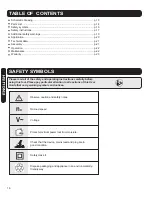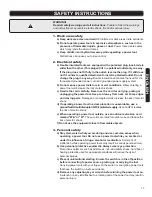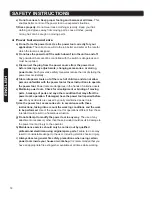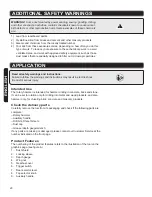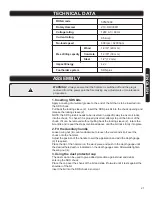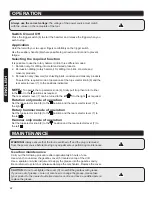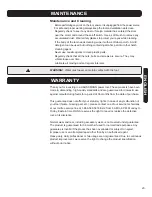
19
ENGLISH
ADDITIONAL SAFETY WARNINGS
1. Hold tools by insulated gripping surfaces when performing an operation
where the tool may contact hidden wiring or its own cord.
Contact with a “live” wire will make exposed metal parts of the tool “live” and
shock the operator. Do not drill, fasten or break into existing walls or other
blind areas where electrical wiring may exist. If this situation is unavoidable,
disconnect all fuses or circuit breakers feeding this worksite.
2. Wear hearing protection when using the tool for extended periods.
Prolonged exposure to high intensity noise can cause hearing loss.
3. Use a metal detector to determine if there are gas or water pipes hidden
in the work area or call the local utility company for assistance before
beginning the operation.
Striking or cutting into a gas line will result in
explosion. Water entering an electrical device may cause electrocution.
4. Always use the side handle for maximum control over torque reaction or
kick-back. Never attempt to operate this tool with one hand.
The slip
clutch engages if you firmly control the tool during a torque reaction or kickback.
5. Always wear safety goggles or eye protection when using this tool. Use
a dust mask or respirator for applications which generate dust.
Safety
goggles or eye protection will help deflect fragments of the material that may
be thrown toward your face and eyes. Dust generated or gases released from
the material you are drilling (i.e. asbestos insulated pipes, radon) may cause
respiratory difficulties.
6. Use thick cushioned gloves and limit the exposure time by taking
frequent rest periods.
Vibration caused by hammer-drill action may be
harmful to your hands and arms.
7. Position the cord clear of rotating bit. Do not wrap the cord around your
arm or wrist.
If cord becomes entangled with the spinning bit it could entrap
you causing serious personal injury.
8. Position yourself to avoid being caught between the tool or side handle
and walls or posts.
Should the bit become bound or jammed in the work, the
reaction torque of the tool could crush your hand or leg.
9. Do not strike the bit with a hand-held hammer or sledge hammer when
attempting to dislodge a bound or jammed bit.
Fragments of metal from
the bit could dislodge and strike you or bystanders.
10. Never place the tool down until the bit or accessory has come to a
complete stop. Do not use dull or damaged bits and accessories.
Dull or
damaged bits have a greater tendency to bind in the workpiece.
11. When removing the bit from the tool avoid contact with skin and use
proper protective gloves when grasping the bit or accessory.
Accessories
may be hot after prolonged use.
12. Do not run the tool while carrying it at your side.
The spinning drill bit may
become entangled with clothing and injury may result.












